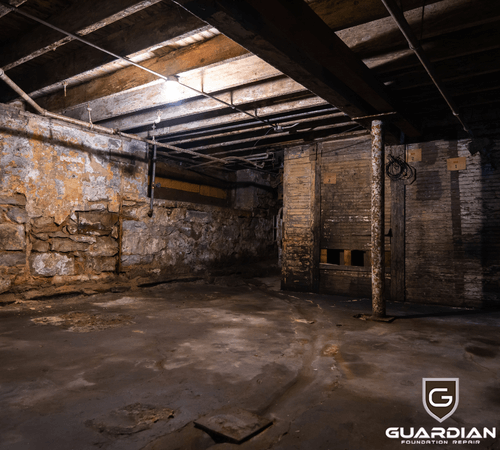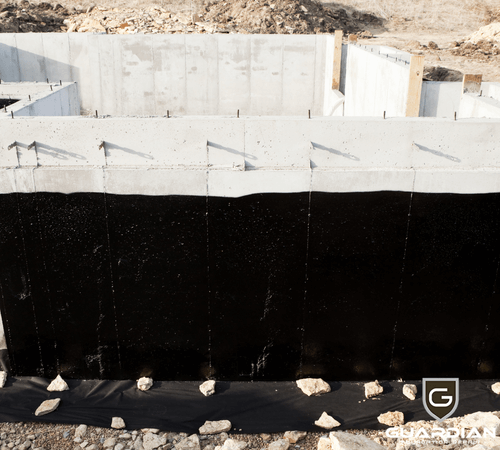Introduction:
Your basement walls are the most critical piece of your Knoxville home’s foundation. Since everything else is resting or built on top of it, any damage to your basement walls could result in significant structural problems. Even the most minor cracks can let in water, leading to mold growth, wood rot, and other serious issues. Additionally, if your basement walls have developed horizontal cracks, bowing, or bulging, it is an enormous warning flag that there is significant damage and immediate repairs are needed.
This blog post will discuss what causes basement walls to crack or bow, the dangers of ignoring these problems, and how Guardian Foundation Repair’s basement wall repair solutions can quickly and effectively solve your problem to avoid further damage to your home.
What Causes Basement Walls to Crack or Bow?
Hydrostatic pressure is the most common reason for a bowing or cracking basement wall. This is when the water table, the underground layer of water that saturates the soil, rises higher than the level of your basement floor. When this happens, the hydrostatic pressure presses against your basement walls from the outside. Over time, this pressure will cause cracks to form or push your walls inward, causing them to bow or bulge.
Bowing can also be caused by daily freeze and thaw cycles of the saturated soil around your home during winter. On cold nights, the water in the ground freezes and expands, exerting extreme pressure on your basement walls. Then, during the day, when the temperatures rise, the frozen water thaws and contracts. The excess water then looks for a place to go and starts the cycle again.
Since most foundation walls are made of concrete, they are not very flexible. Therefore, the freeze and thaw cycles will cause the concrete to slowly crack and break down, allowing water to seep into your basement. These cracks will also allow the soil to shift and settle, putting more pressure on the walls and causing them to bow.
Since cracks are the first sign of bowing, do not hesitate to call a foundation repair expert when you see them in your basement. Be sure to look for any of the following:
- Hairline cracks in the mortar between concrete blocks or bricks
- Cracks in poured concrete walls that are wider at the top than they are at the bottom (this is called “step cracking”)
- Wallpaper that is peeling or separating from the wall
- Doors or windows that are hard to open or close
These are all signs that your basement walls are under stress and could be in danger of bowing or collapsing.
How to Fix a Bowing or Cracked Basement Wall:
Many homeowners in Knoxville believe they can simply patch the cracks in their basement walls and call it a day, something we do not recommend. While patching may temporarily fix the problem, it does not address the root cause of the issue and will only need to be repeated as the cracks spread.
Fixing a bulging basement wall requires foundation repair Knoxville expertise, and depending upon the severity of the bowing, our foundation experts will develop a repair solution that is best for your home.
Some of the standard methods for repairing a bowing basement wall include:
- Carbon Fiber Reinforcement- This is a quick and easy way to reinforce your walls without having to remove any part of your foundation. Small strips of carbon fiber are bonded to the wall with an epoxy resin, creating a grid that strengthens the barrier and prevents it from bowing further.
- Tie back Wall Anchors- If your basement walls are only slightly bowed, wall anchors may be all that is needed to stabilize them. Metal plates are bolted to your foundation walls and connected with steel rods during this repair. The rods are then tightened to pull the border back into place and hold it there while the concrete cures.
- I Beam installation: Our foundation experts will install steel I-beams to reinforce the wall for severely bowed or cracked walls. I-beams are on either side of the wall and connected with cross bracing. It creates a strong frame that can hold the wall in place while it is being repaired.
Waterproofing Basement After Foundation Repair:
Once your basement wall is stabilized, it is important to waterproof it to prevent any future issues. Our basement waterproofing specialists will install a comprehensive system that includes:
- Sump Pump: This will remove any water accumulated in your basement, so it doesn’t cause further damage.
- Drainage System: A French drain or other types of drainage system will be installed around the perimeter of your basement to direct water away from the foundation.
- Dehumidifier: This will help keep the air in your basement dry, preventing mold and mildew from growing.
Related Reading:
Why Your Bowed Basement Wall Needs a Quick Repair:
Bowed walls require a quick fix because the longer you wait, the worse the problem will get, and eventually, the foundation wall could collapse. If that happens, you will have to move out of your home until repairs can be made, which could take weeks or even months. Rebuilding a wall is also a much more expensive repair than stabilizing it. That is why calling a basement repair company is important as soon as you see cracks or bowing in your basement walls.
Guardian Foundation Repair experienced inspectors will thoroughly and expertly assess your basement wall issue and make customized recommendations for your home. We understand that every home is different, so each repair solution must be too. We will work quickly and efficiently to complete your basement wall repair so you can have peace of mind knowing your home is safe.
If you have any questions about repairing a bowed or cracked basement wall, or if you would like to schedule a free inspection, don’t hesitate to contact us today. We look forward to serving you!


